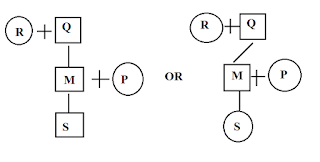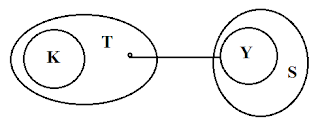Reasoning quiz is to judge your mental as well as the logical ability of thinking. How sharply you think and make an effective decision on a given situation.This reasoning quiz enhances your in preparation for upcoming examination and evaluates your performance. So, do practices on regular basis and increase your selection chances in an upcoming examination. Reasoning section is more scoring section for all in several Banking exams if you have a right approach of decision making for solving the problem.
Mahendra Guru provides you Reasoning Quiz for Bank examination based on the latest pattern. So you can do practice on the regular basis it will definitely help you to score marks in the exam. The reasoning is the most important section for all the govt exam like IBPS PO/ Clerk/SO/RRB RBI, SBI Clerk, Insurance, SSC-MTS, CGL, CHSL, State Level and other Competitive exams.
Q.1-4 Read the following information and answer the questions given below:
Eight friends P, Q, R, S, T, U, V and W are sitting around a circular table facing center. Out of them 4 are male and 4 are female. They all have different occupation Doctor, Engineer, Cricketer, Agriculture officer, Teacher. I.T. officer, Architect and Banker not necessarily in the same order. Male and female are sitting in alternate order. Q is sitting third to the right of cricketer. Banker is not the neighbor of teacher and architect. W is teacher and sitting second to the left of Q. U is the neighbor of cricketer. One who is I.T. officer is a male and sitting next to Architect. V is a doctor and sitting in front of cricketer Architect is sitting between R and cricketer. S is sitting between W and engineer. T is not cricketer.
नीचे दिए गए विवरण को ध्यानपूर्वक पढ़िए एवं पूछे गए प्रश्नों का उत्तर दीजिए -
आठ मित्र P, Q, R, S, T, U, V और W एक वृत्त के परितः केन्द्र की ओर मुख करके बैठे हैं। उनमें से चार पुरूष हैं और चार महिलाएँ हैं। उन सभी के अलग-अलग व्यवसाय है जैसे - डॉक्टर, इंजीनियर, क्रिकेटर, कृषि अधिकारी, अध्यापक, आई. टी. ऑफिसर, आर्किटेक्ट और बैंकर परन्तु क्रम निश्चित नहीं है। पुरूष और महिलाएँ एकांतर क्रम में बैठे हैं। Q, क्रिकेटर के दाएँ तीसरा है। वह व्यक्ति जो बैंकर है , अध्यापक और आर्किटेक्ट का पड़ोसी नहीं है। W अध्यापक है और Q के बाएँ दूसरा है। U, क्रिकेटर का पड़ोसी है। वह व्यक्ति जो आई. टी. ऑफिसर है वह पुरूष है और आर्किटेक्ट का पड़ोसी है। V डॉक्टर है और क्रिकेटर के सामने बैठा है। वह व्यक्ति जो आर्किटेक्ट है , R और क्रिकेटर के मध्य बैठा है। S, W और इंजीनियर के मध्य बैठा है। T क्रिकेटर नहीं है।
Q-1 Who among the following is female ?
(1) V
(2) Q
(3) W
(4) P
(5) Both 2 and 3
इनमें से कौन महिला है ?
(1) V
(2) Q
(3) W
(4) P
(5) दोनों 2 और 3
Q-2 Which of the following is True?
(1) T is a Banker
(2) Teacher is fourth to the right of banker
(3) Q is a female
(4) S is an agriculture officer
(5) All are true
निम्नलिखित में से कौन सत्य है ?
(1) T बैंकर है
(2) अध्यापक, बैंकर के दाएँ चौथा है
(3) Q महिला है
(4) S कृषि अधिकारी है
(5) सभी सत्य है
Q-3 Who among the following is a Doctor?
(1) T
(2) S
(3) V
(4) Data inadequate
(5) None of these
इनमें से कौन डॉक्टर है ?
(1) T
(2) S
(3) V
(4) डाटा अपर्याप्त है
(5) इनमें से कोई नहीं
Q-4 What is the position of U with respect to that of agriculture officer?
(1) Fifth to the right
(2) Third to the left
(3) Both 2 and 3
(4) Data inadequate
(5) Other than these options
कृषि अधिकारी के सापेक्ष U की स्थिति क्या है ?
(1) दाएँ पाँचवा
(2) बाएँ तीसरा
(3) दोनों 2 और 3
(4) डाटा अपर्याप्त है
(5) इन विकल्पों के अलावा
Q-5 Who among the following is not a female?
(1) T
(2) U
(3) Q
(4) R
(5) W
निम्न में से कौन महिला नही है ?
(1) T
(2) U
(3) Q
(4) R
(5) W
Q.6-8 In the following question symbols *, δ, $ and # are used with following meaning.
'A * B' means A is father of B.
'A δ B' means A is son of B.
'A $ B' means A is daughter of B.
'A # B' means A is wife of B.
Give the answer of the following questions.
इन प्रश्नों में चिन्ह *, δ , $ और # निम्न अर्थ के साथ प्रयोग हुए हैं।
'A * B' का अर्थ है 'A, B का पिता है।'
'A δ B' का अर्थ है 'A, B' का पुत्र है।'
'A $ B' का अर्थ है 'A, B' का पुत्री है।'
'A # B' का अर्थ 'A, B' की पत्नी है।'
निम्न प्रश्नों के उत्तर दीजिए -
Q-6 In the following expression how is M related to Q?
M * P # R * Q.
(1) Mother
(2) Brother
(3) Grandfather
(4) Can't be determined
(5) None of these
निम्नलिखित अभिव्यक्ति में M का Q से क्या सम्बन्ध है ?
M * P # R * Q.
(1) माता
(2) भाई
(3) ग्राण्डफादर
(4) निर्धारित नहीं कर सकते
(5) इनमें से कोई नहीं
Q-7 If P is the daughter in law of R, then in the following expression which symbol will replace question mark?
R # Q * M * S? P
(1) δ
(2) $
(3) #
(4) *
(5) Either δ or $
If P is the daughter in law of R, then in the following expression which symbol will replace question mark?
R # Q * M * S ? P
(1) δ
(2) $
(3) #
(4) *
(5) या तो δ या $
Q-8 In the following expression, how is M related to N?
M * P $ S $ N
(1) Son
(2) Son in law
(3) Grand son
(4) Daughter in law
(5) Other than these options
निम्न अभिव्यक्ति में M का N से क्या सम्बन्ध है ?
M * P $ S $ N
(1) पुत्र
(2) दामाद
(3) पोता
(4) बहु
(5) इन विकल्पों के अलावा
Q.9 Each of the questions below has a few statements followed by three conclusions numbered I, II and III. You have to consider every given statements as true, even if it does not conform to the well known facts. Read the conclusions and then decide which of the conclusions can be logically derived.
Statements: All Knife are Toy.
Some Toy are not yellow.
All Yellow are Snow.
Conclusion:
I. All Knife are Yellow.
II. At least some Snow are Knife.
III. No Snow is a Toy.
(1) Only I follows
(2) Only I & III follow
(3) Only II follows
(4) None follows
(5) Only I & II follow
नीचे प्रत्येक प्रश्न में कुछ कथन और उसके बाद तीन निष्कर्ष I, II और III दिये गये है। आपको दिये गये कथनों को सत्य मानना है चाहे वे सामान्यतः ज्ञात तथ्यों से भिन्न क्यो न हो। निष्कर्ष को पढे और तय करे कौन-सा तार्किक रूप से अनुसरण करता है। भले ही वे सामान्यतः ज्ञात तथ्यों से भिन्न क्यों न हो। निष्कर्षों को पढ़ें और तय करें कि कौन-से निष्कर्ष तार्किक रूप से अनुसरण करते हैं।
कथन:
सभी चाकू, खिलौना हैं।
कुछ खिलौना, पीले नहीं हैं।
सभी पीले, हिमपात हैं।
निष्कर्ष:
I. सभी चाकू, पीले हैं।
II. कम से कम कुछ हिमपात, चाकू हैं।
III. कोई हिमपात, खिलौना नहीं है।
(1) केवल I अनुसरण करता है।
(2) केवल I और III अनुसरण करते है।
(3) केवल II अनुसरण करता है।
(4) कोई अनुसरण नहीं करता है।
(5) केवल I और II अनुसरण करते है।
Q-10 Each of the questions below has a few statements followed by four conclusions numbered I, II and III. You have to consider every given statements as true, even if it does not conform to the well known facts. Read the conclusions and then decide which of the conclusions can be logically derived.
Statements: Some Nail are Orange.
No Orange is a Knell.
Some Knell are Honey.
Conclusion:
I. All Orange are Honey.
II. Some Honey are not Orange.
III. Some Nail are not Knell.
(1) Only I follows
(2) Only II follows
(3) Only III follows
(4) None follow
(5) Only II & III follow
नीचे प्रत्येक प्रश्न में कुछ कथन और उसके बाद तीन निष्कर्ष I, II और III दिये गये है। आपको दिये गये कथनों को सत्य मानना है चाहे वे सामान्यतः ज्ञात तथ्यों से भिन्न क्यो न हो। निष्कर्ष को पढे और तय करे कौन-सा तार्किक रूप से अनुसरण करता है। ले ही वे सामान्यतः ज्ञात तथ्यों से भिन्न क्यों न हो। निष्कर्षों को पढ़ें और तय करें कि कौन-से निष्कर्ष तार्किक रूप से अनुसरण करते हैं।
कथनः कुछ नेल, ऑरेंज हैं।
कोई ऑरेंज, समाप्ति नहीं है।
कुछ समाप्ति, हनी हैं।
निष्कर्ष:
I. सभी ऑरेंज, हनी हैं।
II. कुछ हनी, ऑरेंज नहीं हैं।
III. कुछ नेल, समाप्ति नहीं हैं।
(1) केवल I अनुसरण करता है।
(2) केवल II अनुसरण करता है।
(3) केवल III अनुसरण करता है।
(4) कोई अनुसरण नहीं करता हैं।
(5) केवल II और III अनुसरण करते है।
SOLUTION:-
Q.1-5

Q.1 (5), Q.2 (5), Q.3 (3), Q.4 (5), Q.5 (4),
Q.6 (3)

Q.7 (5)

Q.8 (2)

Q.9 (4)

Q.10 (5)






.jpg)